Taxation Law .
VerifiedAdded on 2023/05/29
|8
|1820
|500
AI Summary
This text provides answers to questions related to Australian taxation law, including residency status, income tax on gifts and prizes, and deductions for business loans. The text also includes computations for net income and taxable income. References to relevant cases and legislation are provided throughout.
Contribute Materials
Your contribution can guide someone’s learning journey. Share your
documents today.
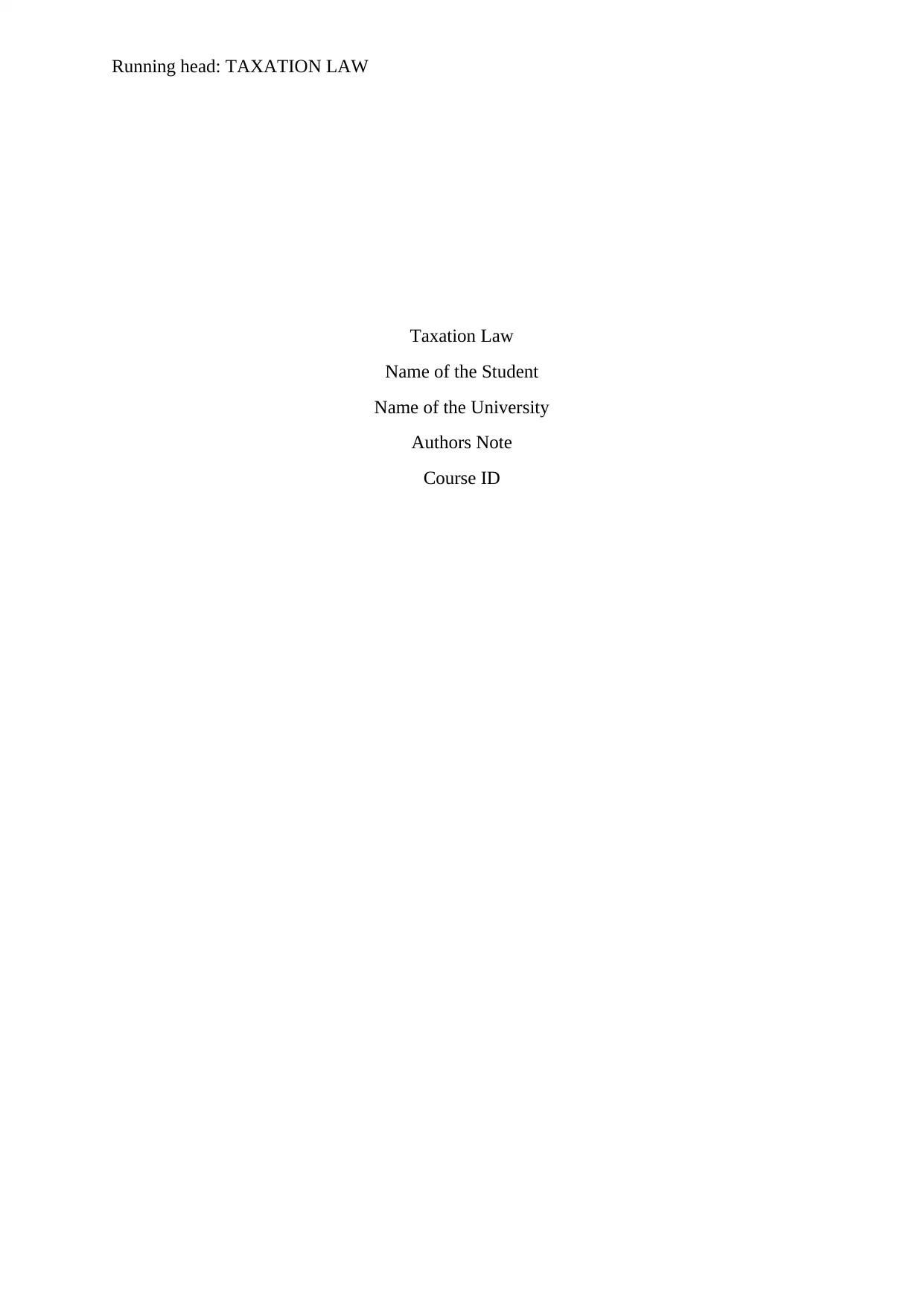
Running head: TAXATION LAW
Taxation Law
Name of the Student
Name of the University
Authors Note
Course ID
Taxation Law
Name of the Student
Name of the University
Authors Note
Course ID
Secure Best Marks with AI Grader
Need help grading? Try our AI Grader for instant feedback on your assignments.
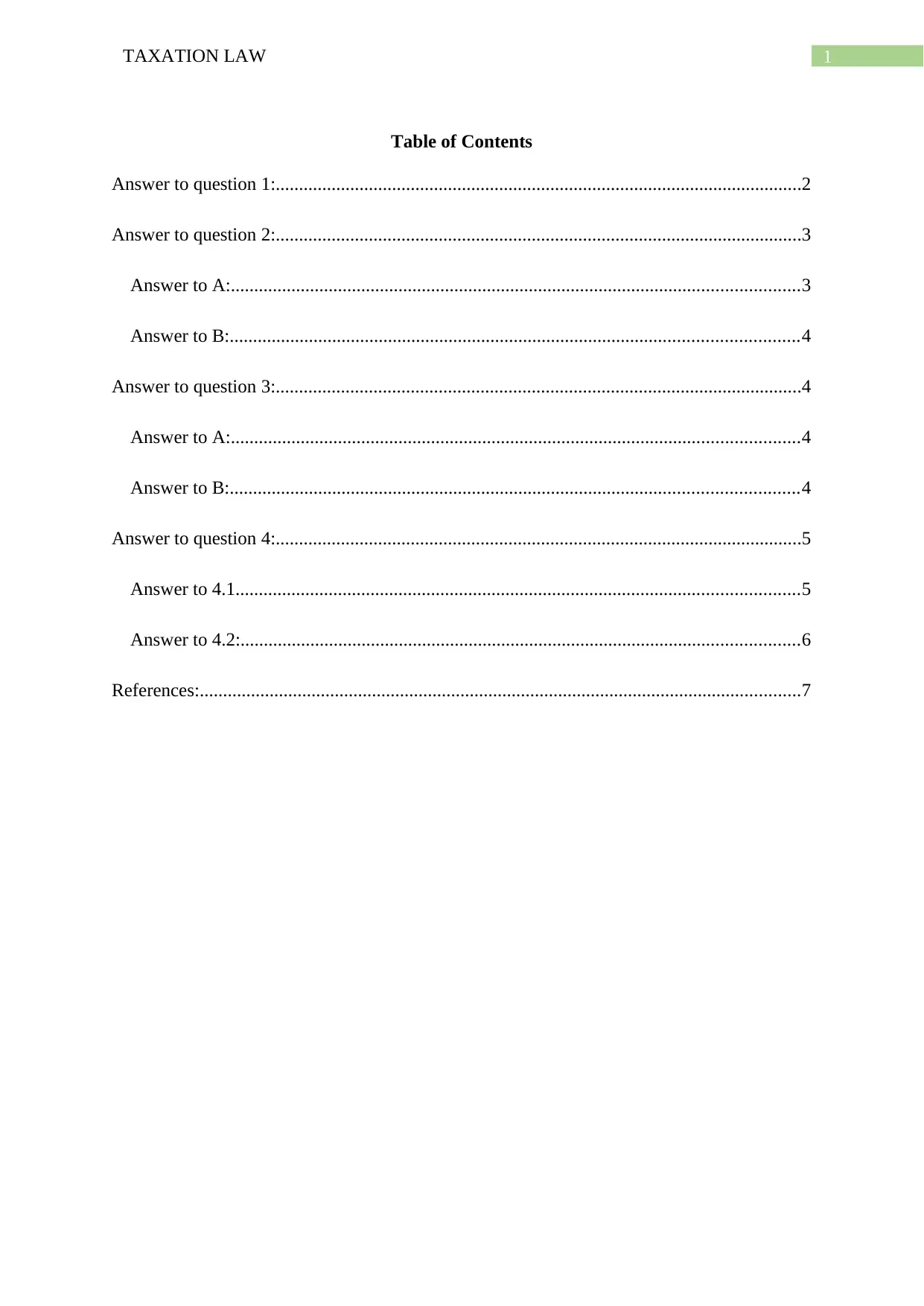
1TAXATION LAW
Table of Contents
Answer to question 1:.................................................................................................................2
Answer to question 2:.................................................................................................................3
Answer to A:..........................................................................................................................3
Answer to B:..........................................................................................................................4
Answer to question 3:.................................................................................................................4
Answer to A:..........................................................................................................................4
Answer to B:..........................................................................................................................4
Answer to question 4:.................................................................................................................5
Answer to 4.1.........................................................................................................................5
Answer to 4.2:........................................................................................................................6
References:.................................................................................................................................7
Table of Contents
Answer to question 1:.................................................................................................................2
Answer to question 2:.................................................................................................................3
Answer to A:..........................................................................................................................3
Answer to B:..........................................................................................................................4
Answer to question 3:.................................................................................................................4
Answer to A:..........................................................................................................................4
Answer to B:..........................................................................................................................4
Answer to question 4:.................................................................................................................5
Answer to 4.1.........................................................................................................................5
Answer to 4.2:........................................................................................................................6
References:.................................................................................................................................7
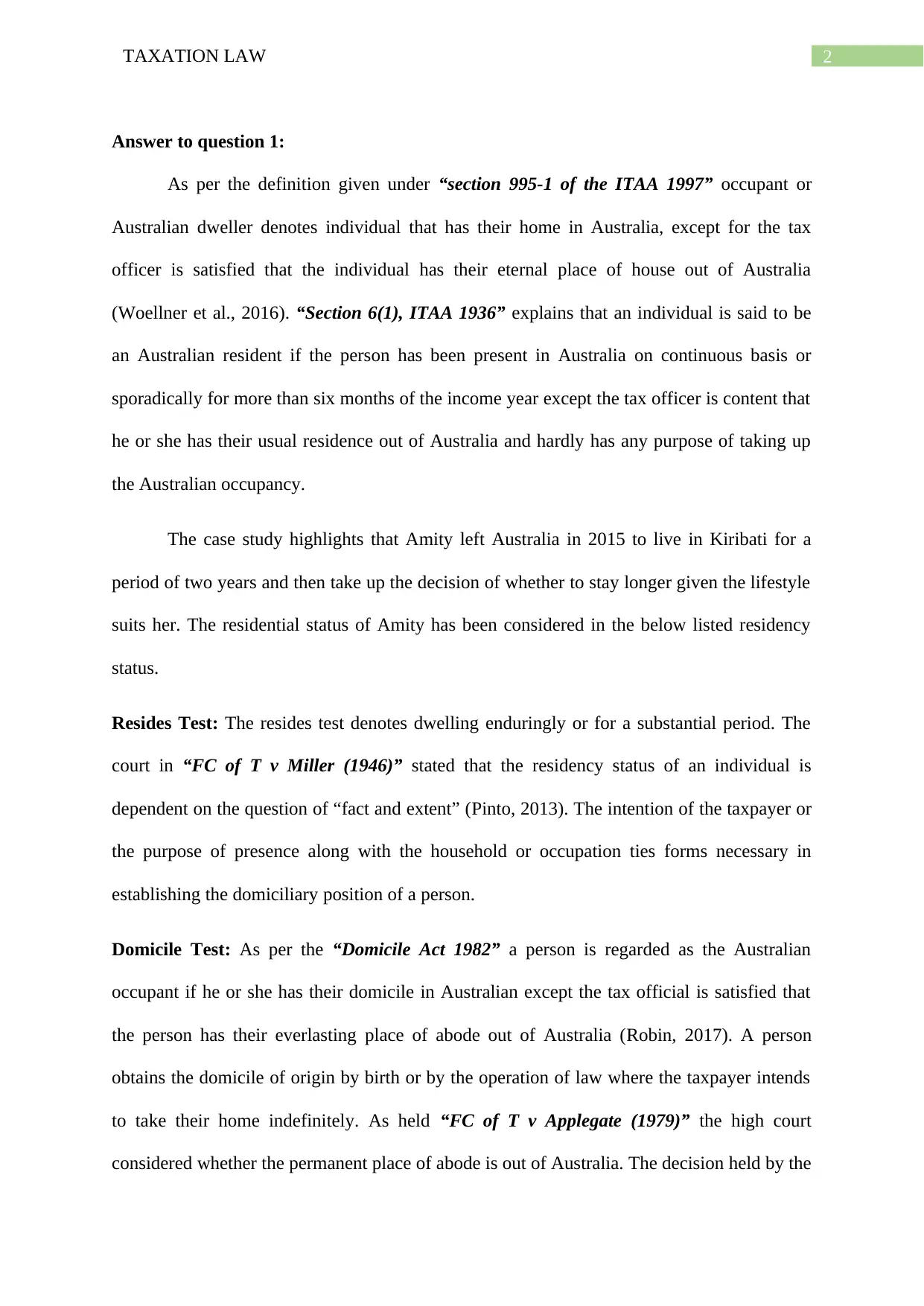
2TAXATION LAW
Answer to question 1:
As per the definition given under “section 995-1 of the ITAA 1997” occupant or
Australian dweller denotes individual that has their home in Australia, except for the tax
officer is satisfied that the individual has their eternal place of house out of Australia
(Woellner et al., 2016). “Section 6(1), ITAA 1936” explains that an individual is said to be
an Australian resident if the person has been present in Australia on continuous basis or
sporadically for more than six months of the income year except the tax officer is content that
he or she has their usual residence out of Australia and hardly has any purpose of taking up
the Australian occupancy.
The case study highlights that Amity left Australia in 2015 to live in Kiribati for a
period of two years and then take up the decision of whether to stay longer given the lifestyle
suits her. The residential status of Amity has been considered in the below listed residency
status.
Resides Test: The resides test denotes dwelling enduringly or for a substantial period. The
court in “FC of T v Miller (1946)” stated that the residency status of an individual is
dependent on the question of “fact and extent” (Pinto, 2013). The intention of the taxpayer or
the purpose of presence along with the household or occupation ties forms necessary in
establishing the domiciliary position of a person.
Domicile Test: As per the “Domicile Act 1982” a person is regarded as the Australian
occupant if he or she has their domicile in Australian except the tax official is satisfied that
the person has their everlasting place of abode out of Australia (Robin, 2017). A person
obtains the domicile of origin by birth or by the operation of law where the taxpayer intends
to take their home indefinitely. As held “FC of T v Applegate (1979)” the high court
considered whether the permanent place of abode is out of Australia. The decision held by the
Answer to question 1:
As per the definition given under “section 995-1 of the ITAA 1997” occupant or
Australian dweller denotes individual that has their home in Australia, except for the tax
officer is satisfied that the individual has their eternal place of house out of Australia
(Woellner et al., 2016). “Section 6(1), ITAA 1936” explains that an individual is said to be
an Australian resident if the person has been present in Australia on continuous basis or
sporadically for more than six months of the income year except the tax officer is content that
he or she has their usual residence out of Australia and hardly has any purpose of taking up
the Australian occupancy.
The case study highlights that Amity left Australia in 2015 to live in Kiribati for a
period of two years and then take up the decision of whether to stay longer given the lifestyle
suits her. The residential status of Amity has been considered in the below listed residency
status.
Resides Test: The resides test denotes dwelling enduringly or for a substantial period. The
court in “FC of T v Miller (1946)” stated that the residency status of an individual is
dependent on the question of “fact and extent” (Pinto, 2013). The intention of the taxpayer or
the purpose of presence along with the household or occupation ties forms necessary in
establishing the domiciliary position of a person.
Domicile Test: As per the “Domicile Act 1982” a person is regarded as the Australian
occupant if he or she has their domicile in Australian except the tax official is satisfied that
the person has their everlasting place of abode out of Australia (Robin, 2017). A person
obtains the domicile of origin by birth or by the operation of law where the taxpayer intends
to take their home indefinitely. As held “FC of T v Applegate (1979)” the high court
considered whether the permanent place of abode is out of Australia. The decision held by the
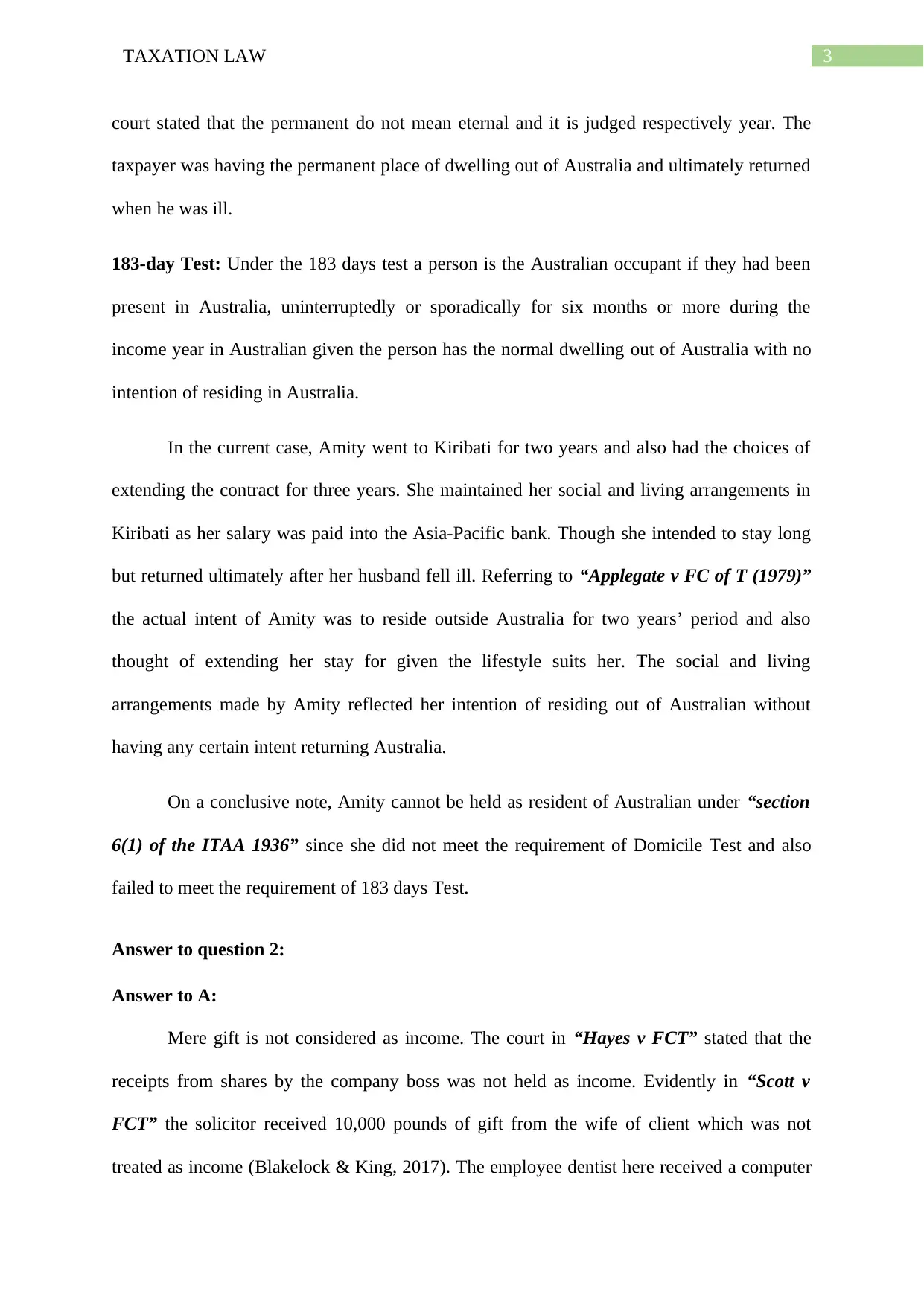
3TAXATION LAW
court stated that the permanent do not mean eternal and it is judged respectively year. The
taxpayer was having the permanent place of dwelling out of Australia and ultimately returned
when he was ill.
183-day Test: Under the 183 days test a person is the Australian occupant if they had been
present in Australia, uninterruptedly or sporadically for six months or more during the
income year in Australian given the person has the normal dwelling out of Australia with no
intention of residing in Australia.
In the current case, Amity went to Kiribati for two years and also had the choices of
extending the contract for three years. She maintained her social and living arrangements in
Kiribati as her salary was paid into the Asia-Pacific bank. Though she intended to stay long
but returned ultimately after her husband fell ill. Referring to “Applegate v FC of T (1979)”
the actual intent of Amity was to reside outside Australia for two years’ period and also
thought of extending her stay for given the lifestyle suits her. The social and living
arrangements made by Amity reflected her intention of residing out of Australian without
having any certain intent returning Australia.
On a conclusive note, Amity cannot be held as resident of Australian under “section
6(1) of the ITAA 1936” since she did not meet the requirement of Domicile Test and also
failed to meet the requirement of 183 days Test.
Answer to question 2:
Answer to A:
Mere gift is not considered as income. The court in “Hayes v FCT” stated that the
receipts from shares by the company boss was not held as income. Evidently in “Scott v
FCT” the solicitor received 10,000 pounds of gift from the wife of client which was not
treated as income (Blakelock & King, 2017). The employee dentist here received a computer
court stated that the permanent do not mean eternal and it is judged respectively year. The
taxpayer was having the permanent place of dwelling out of Australia and ultimately returned
when he was ill.
183-day Test: Under the 183 days test a person is the Australian occupant if they had been
present in Australia, uninterruptedly or sporadically for six months or more during the
income year in Australian given the person has the normal dwelling out of Australia with no
intention of residing in Australia.
In the current case, Amity went to Kiribati for two years and also had the choices of
extending the contract for three years. She maintained her social and living arrangements in
Kiribati as her salary was paid into the Asia-Pacific bank. Though she intended to stay long
but returned ultimately after her husband fell ill. Referring to “Applegate v FC of T (1979)”
the actual intent of Amity was to reside outside Australia for two years’ period and also
thought of extending her stay for given the lifestyle suits her. The social and living
arrangements made by Amity reflected her intention of residing out of Australian without
having any certain intent returning Australia.
On a conclusive note, Amity cannot be held as resident of Australian under “section
6(1) of the ITAA 1936” since she did not meet the requirement of Domicile Test and also
failed to meet the requirement of 183 days Test.
Answer to question 2:
Answer to A:
Mere gift is not considered as income. The court in “Hayes v FCT” stated that the
receipts from shares by the company boss was not held as income. Evidently in “Scott v
FCT” the solicitor received 10,000 pounds of gift from the wife of client which was not
treated as income (Blakelock & King, 2017). The employee dentist here received a computer
Secure Best Marks with AI Grader
Need help grading? Try our AI Grader for instant feedback on your assignments.
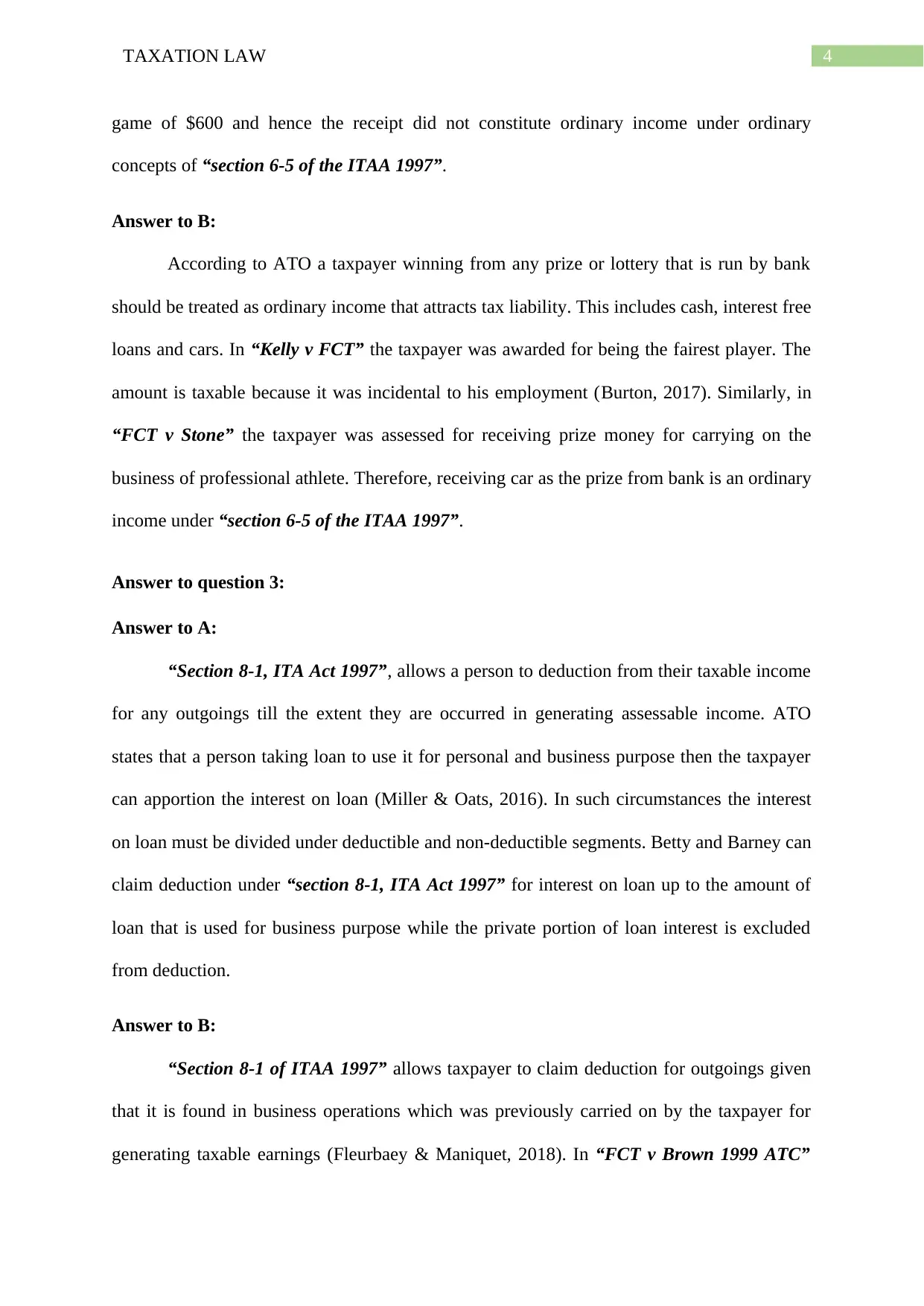
4TAXATION LAW
game of $600 and hence the receipt did not constitute ordinary income under ordinary
concepts of “section 6-5 of the ITAA 1997”.
Answer to B:
According to ATO a taxpayer winning from any prize or lottery that is run by bank
should be treated as ordinary income that attracts tax liability. This includes cash, interest free
loans and cars. In “Kelly v FCT” the taxpayer was awarded for being the fairest player. The
amount is taxable because it was incidental to his employment (Burton, 2017). Similarly, in
“FCT v Stone” the taxpayer was assessed for receiving prize money for carrying on the
business of professional athlete. Therefore, receiving car as the prize from bank is an ordinary
income under “section 6-5 of the ITAA 1997”.
Answer to question 3:
Answer to A:
“Section 8-1, ITA Act 1997”, allows a person to deduction from their taxable income
for any outgoings till the extent they are occurred in generating assessable income. ATO
states that a person taking loan to use it for personal and business purpose then the taxpayer
can apportion the interest on loan (Miller & Oats, 2016). In such circumstances the interest
on loan must be divided under deductible and non-deductible segments. Betty and Barney can
claim deduction under “section 8-1, ITA Act 1997” for interest on loan up to the amount of
loan that is used for business purpose while the private portion of loan interest is excluded
from deduction.
Answer to B:
“Section 8-1 of ITAA 1997” allows taxpayer to claim deduction for outgoings given
that it is found in business operations which was previously carried on by the taxpayer for
generating taxable earnings (Fleurbaey & Maniquet, 2018). In “FCT v Brown 1999 ATC”
game of $600 and hence the receipt did not constitute ordinary income under ordinary
concepts of “section 6-5 of the ITAA 1997”.
Answer to B:
According to ATO a taxpayer winning from any prize or lottery that is run by bank
should be treated as ordinary income that attracts tax liability. This includes cash, interest free
loans and cars. In “Kelly v FCT” the taxpayer was awarded for being the fairest player. The
amount is taxable because it was incidental to his employment (Burton, 2017). Similarly, in
“FCT v Stone” the taxpayer was assessed for receiving prize money for carrying on the
business of professional athlete. Therefore, receiving car as the prize from bank is an ordinary
income under “section 6-5 of the ITAA 1997”.
Answer to question 3:
Answer to A:
“Section 8-1, ITA Act 1997”, allows a person to deduction from their taxable income
for any outgoings till the extent they are occurred in generating assessable income. ATO
states that a person taking loan to use it for personal and business purpose then the taxpayer
can apportion the interest on loan (Miller & Oats, 2016). In such circumstances the interest
on loan must be divided under deductible and non-deductible segments. Betty and Barney can
claim deduction under “section 8-1, ITA Act 1997” for interest on loan up to the amount of
loan that is used for business purpose while the private portion of loan interest is excluded
from deduction.
Answer to B:
“Section 8-1 of ITAA 1997” allows taxpayer to claim deduction for outgoings given
that it is found in business operations which was previously carried on by the taxpayer for
generating taxable earnings (Fleurbaey & Maniquet, 2018). In “FCT v Brown 1999 ATC”

5TAXATION LAW
the taxation commissioner allowed deduction for interest on loan since the loan was entered
into by the taxpayer to conduct the business activities and for generating income.
i. A deduction under “section 8-1 of the ITAA 1997” will be permitted to Robert for
loan interest when the business was under continuous mode.
ii. Robert would also be permitted to claim deduction under “section 8-1 of the
ITAA 1997” when the business operation was ceased since the loan was entered
into by the taxpayer to conduct the business activities and for generating income.
Answer to question 4:
Answer to 4.1
Particulars Amount ($) Section Explanation
Assessable Receipts
Receipts from Sale 527000 Section 6-5 of the ITAA 1997 Ordinary Income
Proceeds from loan 500000
Receipts from Supplier 10000
Total Assesable Income Section 6-5 of the ITAA 1997 Ordinary Income
Total Assessable Receipts 1037000
Allowable Deductions
Purchase of Trading Stock 275000 Section 8-1 of the ITAA 1997 General Deductions
Wages paid to employees 42000 Section 8-1 of the ITAA 1997 General Deductions
Loan repayment interest 21890 Section 8-1 of the ITAA 1997 General Deductions
Rent on premises 145000 Section 8-1 of the ITAA 1997 General Deductions
Other Expenses 75000 Section 8-1 of the ITAA 1997 General Deductions
Cost of Goods Sold 254900 Section 8-1 of the ITAA 1997 General Deductions
Total Allowable Deductions 813790
Total Income 223210
Computation of Net Income from Business
The court in “FCT v Harris” held that mere windfall gains are not treated as income.
The winning from lottery by Lincoln will not be held as income because it is windfall gain
(Sikka, 2017). He also received incentive for display of game console in his window. The
receipt constitutes ordinary income under “section 6-5 of the ITAA 1997” because it was
received during the business course.
the taxation commissioner allowed deduction for interest on loan since the loan was entered
into by the taxpayer to conduct the business activities and for generating income.
i. A deduction under “section 8-1 of the ITAA 1997” will be permitted to Robert for
loan interest when the business was under continuous mode.
ii. Robert would also be permitted to claim deduction under “section 8-1 of the
ITAA 1997” when the business operation was ceased since the loan was entered
into by the taxpayer to conduct the business activities and for generating income.
Answer to question 4:
Answer to 4.1
Particulars Amount ($) Section Explanation
Assessable Receipts
Receipts from Sale 527000 Section 6-5 of the ITAA 1997 Ordinary Income
Proceeds from loan 500000
Receipts from Supplier 10000
Total Assesable Income Section 6-5 of the ITAA 1997 Ordinary Income
Total Assessable Receipts 1037000
Allowable Deductions
Purchase of Trading Stock 275000 Section 8-1 of the ITAA 1997 General Deductions
Wages paid to employees 42000 Section 8-1 of the ITAA 1997 General Deductions
Loan repayment interest 21890 Section 8-1 of the ITAA 1997 General Deductions
Rent on premises 145000 Section 8-1 of the ITAA 1997 General Deductions
Other Expenses 75000 Section 8-1 of the ITAA 1997 General Deductions
Cost of Goods Sold 254900 Section 8-1 of the ITAA 1997 General Deductions
Total Allowable Deductions 813790
Total Income 223210
Computation of Net Income from Business
The court in “FCT v Harris” held that mere windfall gains are not treated as income.
The winning from lottery by Lincoln will not be held as income because it is windfall gain
(Sikka, 2017). He also received incentive for display of game console in his window. The
receipt constitutes ordinary income under “section 6-5 of the ITAA 1997” because it was
received during the business course.
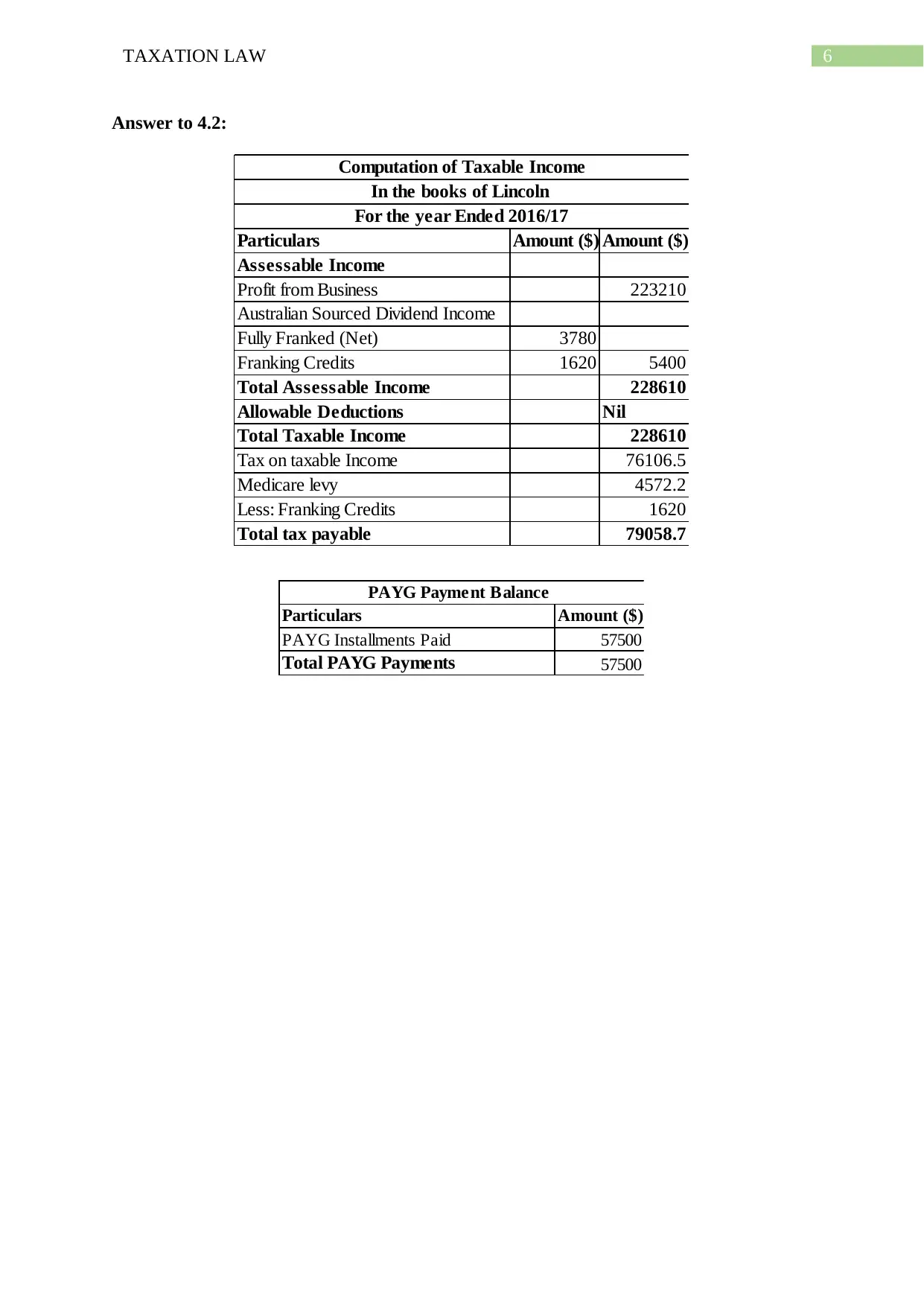
6TAXATION LAW
Answer to 4.2:
Particulars Amount ($) Amount ($)
Assessable Income
Profit from Business 223210
Australian Sourced Dividend Income
Fully Franked (Net) 3780
Franking Credits 1620 5400
Total Assessable Income 228610
Allowable Deductions Nil
Total Taxable Income 228610
Tax on taxable Income 76106.5
Medicare levy 4572.2
Less: Franking Credits 1620
Total tax payable 79058.7
Computation of Taxable Income
In the books of Lincoln
For the year Ended 2016/17
Particulars Amount ($)
PAYG Installments Paid 57500
Total PAYG Payments 57500
PAYG Payment Balance
Answer to 4.2:
Particulars Amount ($) Amount ($)
Assessable Income
Profit from Business 223210
Australian Sourced Dividend Income
Fully Franked (Net) 3780
Franking Credits 1620 5400
Total Assessable Income 228610
Allowable Deductions Nil
Total Taxable Income 228610
Tax on taxable Income 76106.5
Medicare levy 4572.2
Less: Franking Credits 1620
Total tax payable 79058.7
Computation of Taxable Income
In the books of Lincoln
For the year Ended 2016/17
Particulars Amount ($)
PAYG Installments Paid 57500
Total PAYG Payments 57500
PAYG Payment Balance
Paraphrase This Document
Need a fresh take? Get an instant paraphrase of this document with our AI Paraphraser
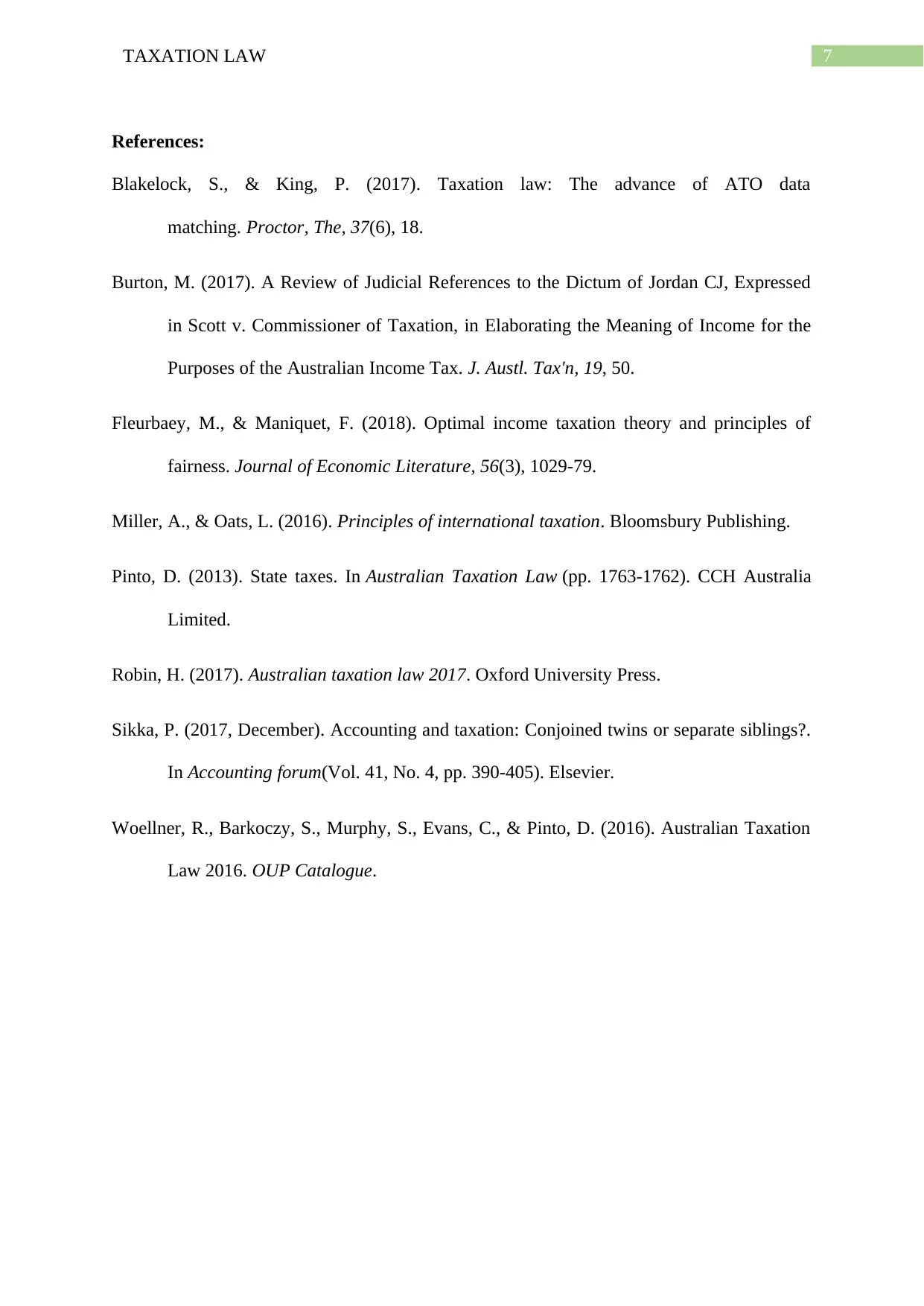
7TAXATION LAW
References:
Blakelock, S., & King, P. (2017). Taxation law: The advance of ATO data
matching. Proctor, The, 37(6), 18.
Burton, M. (2017). A Review of Judicial References to the Dictum of Jordan CJ, Expressed
in Scott v. Commissioner of Taxation, in Elaborating the Meaning of Income for the
Purposes of the Australian Income Tax. J. Austl. Tax'n, 19, 50.
Fleurbaey, M., & Maniquet, F. (2018). Optimal income taxation theory and principles of
fairness. Journal of Economic Literature, 56(3), 1029-79.
Miller, A., & Oats, L. (2016). Principles of international taxation. Bloomsbury Publishing.
Pinto, D. (2013). State taxes. In Australian Taxation Law (pp. 1763-1762). CCH Australia
Limited.
Robin, H. (2017). Australian taxation law 2017. Oxford University Press.
Sikka, P. (2017, December). Accounting and taxation: Conjoined twins or separate siblings?.
In Accounting forum(Vol. 41, No. 4, pp. 390-405). Elsevier.
Woellner, R., Barkoczy, S., Murphy, S., Evans, C., & Pinto, D. (2016). Australian Taxation
Law 2016. OUP Catalogue.
References:
Blakelock, S., & King, P. (2017). Taxation law: The advance of ATO data
matching. Proctor, The, 37(6), 18.
Burton, M. (2017). A Review of Judicial References to the Dictum of Jordan CJ, Expressed
in Scott v. Commissioner of Taxation, in Elaborating the Meaning of Income for the
Purposes of the Australian Income Tax. J. Austl. Tax'n, 19, 50.
Fleurbaey, M., & Maniquet, F. (2018). Optimal income taxation theory and principles of
fairness. Journal of Economic Literature, 56(3), 1029-79.
Miller, A., & Oats, L. (2016). Principles of international taxation. Bloomsbury Publishing.
Pinto, D. (2013). State taxes. In Australian Taxation Law (pp. 1763-1762). CCH Australia
Limited.
Robin, H. (2017). Australian taxation law 2017. Oxford University Press.
Sikka, P. (2017, December). Accounting and taxation: Conjoined twins or separate siblings?.
In Accounting forum(Vol. 41, No. 4, pp. 390-405). Elsevier.
Woellner, R., Barkoczy, S., Murphy, S., Evans, C., & Pinto, D. (2016). Australian Taxation
Law 2016. OUP Catalogue.
1 out of 8
Related Documents
Your All-in-One AI-Powered Toolkit for Academic Success.
+13062052269
info@desklib.com
Available 24*7 on WhatsApp / Email
![[object Object]](/_next/static/media/star-bottom.7253800d.svg)
Unlock your academic potential
© 2024 | Zucol Services PVT LTD | All rights reserved.




